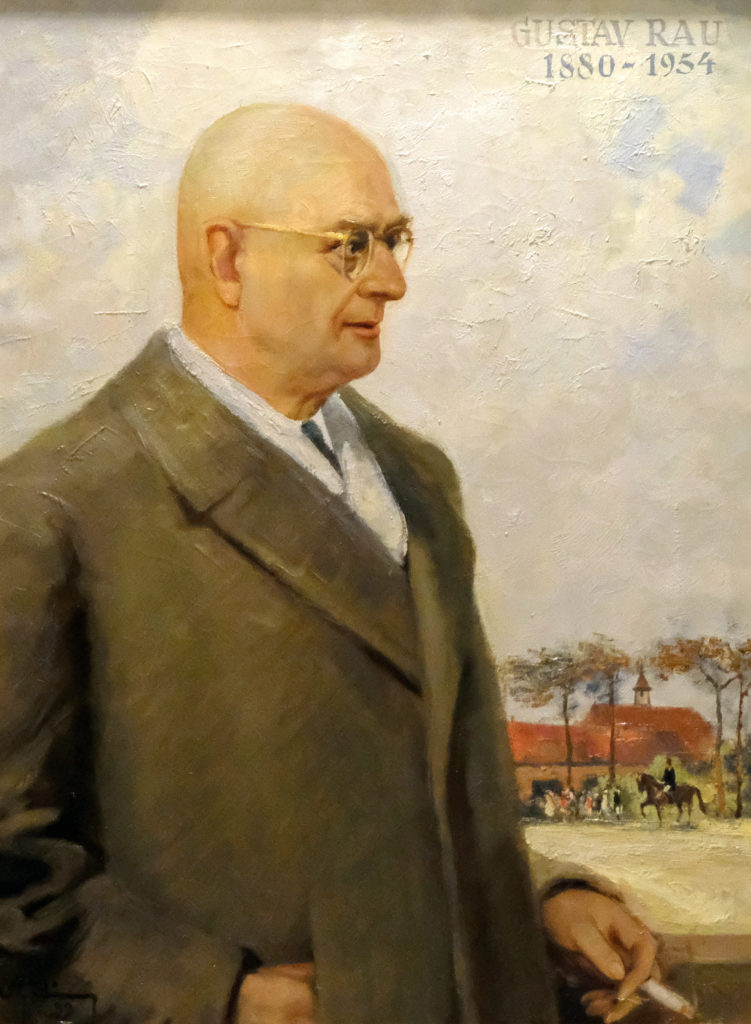
The question is often asked, why does Germany lead the world in equestrian sport? Obviously there are many factors, but it can’t be denied that one man, Gustav Rau was responsible for not only the brilliant breeding program, but also for the riding club system that spread throughout the country, and is the backbone of equestrian sport in Germany…
To take up this story is my friend and colleague, Thomas Hartwig, who was for 14 years the press officer of the German FN, and today is widely regarded as an expert on German equestrian history:
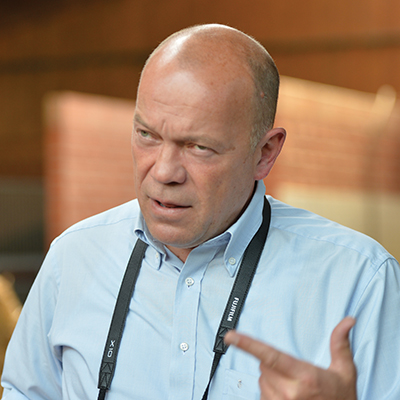
The Phenomenon of Dr Gustav Rau – Without structures, all is nothing
Every nation who wants to have success in the horse sport, needs visionary and enthusiastic breeders who are breeding the right horses in a great number, experienced trainers and talented riders. But what we often forget is, that there needs to be more for sustained success. It needs structures and organizations that are able to combine the skills and efforts of breeders, trainers and riders in the best and most effective way. The person who was the greatest organizational talent in horse sport and the breeding in the twentieth century was Dr Gustav Rau.
Rau influenced the sport and the breeding in Germany as a functionary and an official over more than 40 years. It´s no overstatement to call him the father of the organized horse sport in Germany.
Gustav Rau was born on February 28th in the year 1880 in the French capital, Paris. His father was a former officer in the army of Württemberg, a small kingdom in the Southwest of Germany, which existed until 1918. He worked in Paris as an agent for a photographic art company.
Gustav Rau’s ancestors were farmers and rangers at the “Schwäbische Alb” a rough and barren highland area in the Southwest of Germany. When Gustav Rau was twelve years old, his father died and his mother went first to Switzerland, and later to Stuttgart, the capital of Baden-Württemberg.
After his graduation from secondary school, he started a commercial education at a grain store. Later on he worked for two years on a farm. At the age of 21 Rau got a job in Berlin as an editor at the newspaper “Sport-Welt”, the most famous magazine for all kinds of horse sport and breeding. At this time, the sport of racing was much more important than the early competitions for dressage or show jumping which were still developing in this period in Germany.
Rau attended lectures at the veterinary and agricultural university of Berlin. First he wrote articles about Warmblood horse breeding, and later on about the breeding of Thoroughbreds and Trotters and also about horse shows. His articles were mostly critical, but very analytic.
In a very short time Rau became accepted as a perfect observer and commentator on all things of horse sport and breeding.
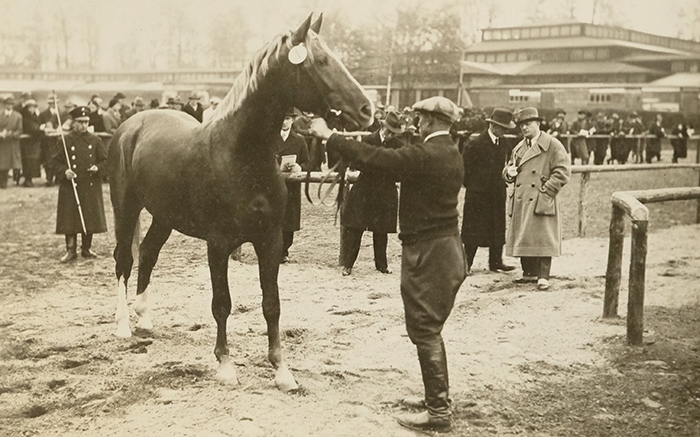
Gustav Rau in the bright coat on the right side during an stallion licensing in the late 20s
or early 30s of the 20thcentury.
Even today it is a mystery where the young Rau got his great knowledge about horses and breeding. At this time German horse breeding did not have a good image, and German breeders sometimes faked the documents of their horses to make a German horse into a foreign horse, because foreign horses were much more favoured in Germany.
story continues below the advertisement
Rau wrote books about horse breeding, and travelled a lot through countries like Great Britain, Austria, Russia, Hungary, France, Italy, The Netherlands and Belgium to study horse breeding. Later on Rau became a member of the Prussian state commission for horse breeding.
In the beginning of 1913 Rau was appointed as a General Secretary of the newly founded German Olympic Committee for Equestrian Sport (DOKR), which was to organize the equestrian parts of the Olympic Games of 1916 in Berlin, but we never held because of the War. In the First World War Rau was a lieutenant in a lancer cavalry regiment. He was wounded three times.
After the First World War was a very bad time for the German horse breeding. The army which had been the most important buyer of Warmblood horses was reduced to 100,000 soldiers and so the demand for horses was reduced by nearly 90%.
Also, in spite of the dramatic economic developments in Germany at this time, the first tractors and trucks were coming into use. To get some idea of how important horse breeding was iat the beginning of the 20thcentury, in 1900 in Germany there was an average of seven horses working on each100 hectares of agricultural land. In East Prussia, which was in this time part of Germany, the average was eleven horses.
The inspired vision of Rau was, to create a new job for the horses. He motivated people, especially in the rural part of Germany, to breed Warmblood horses, not only for farm and transport, but also for riding and sport.
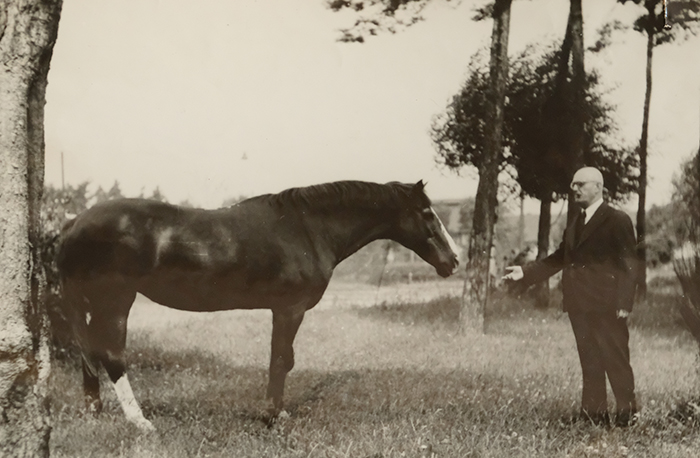
Gustav Rau and Tora. The mare Tora won two Gold Medals at the 1936 Olympic Games with her rider Kurt Hasse. She spent her retirement on the former cavalry school and the later headquarters of DOKR in Warendorf ,and was allowed to walk free over the area.
She died in the age of 30 years in the same year as Gustav Rau.
To this end, he promoted the founding of public riding clubs. His slogan was, that every village in the rural parts of Germany should have its own riding club where the children of the farmers and the breeders could learn riding and handling with horses.
Especially in the Western and Northern parts of Germany – the traditional areas of horse breeding – this initiative was a great success. Hundreds of clubs were founded in the decade of the 20s and a lot of horse and breeding shows arose in this time. It was also a time when new people outside the army or the upper classes found their way to the horse sport. It is an old fairy tale that in this time all farmers were good riders, but the most of them had good experience in the handling of horses.
Nowadays there are almost 10,000 clubs catering for everyone from keen kids to serious competitors. Even the most famous of elite riders, have to be members of their local club. Many riders stable their horses at their club, enjoying the social life as well as the convenience of stabling at a club.
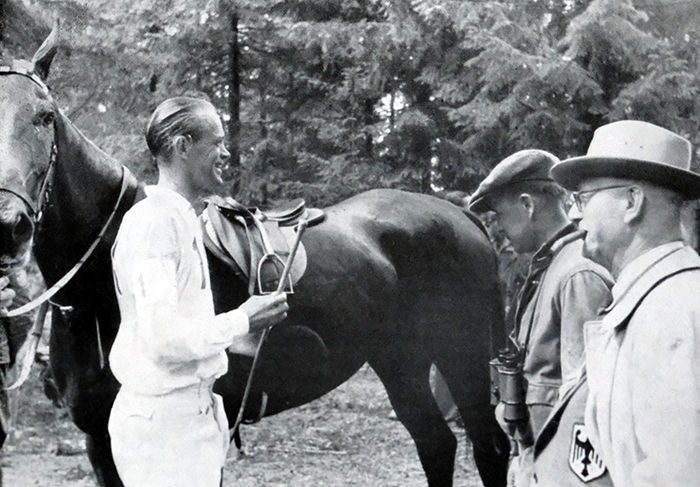
Gustav Rau and Dr Willi Büsing who won a bronze and silver medal in eventing at the Olympic Games 1952 in Helsinki.
In the Olympic Games of 1928 German dressage and eventing riders won their first medals since 1912. Only the show jumpers won no Olympic Medals. The reaction of Rau was the founding of the special discipline stables at the cavalry school in Hannover.
In the short time of some years the cavalry school in Hannover produced a lot of perfect riders and also trainers. A lot of successful trainers and riders after the Second World War started their career in the cavalry school in Hannover. In the year 1933 Rau was appointed as the Chief of Prussian stud administration and so he was the highest official of all German state studs. Only one year later, after a disagreement, he lost this job, but a short time later he was appointed to organize the equestrian elements of the Olympic Games of 1936. In every sense, in this rôle, he did a perfect job.
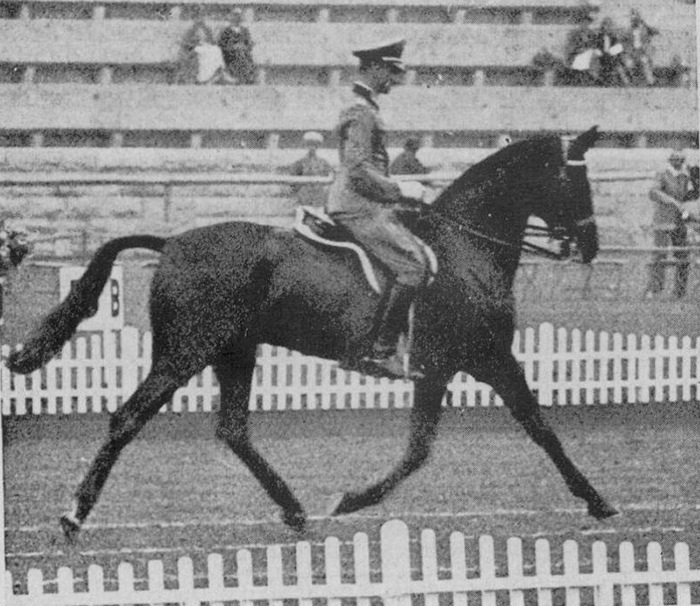
First Lieutenant Heinz Pollay with Kronos who won individual and team gold medal in dressage at the Olympic Games 1936 in Berlin. Rau comments in his book:
“Extended trot on the diagonal. High degree of energy. Complete equilibrium of the horse. Full harmony between rider and horse.”
The Olympic Equestrian Games 1936 were a quality highlight in the history of horse sport, and the German riders won all six gold medals. About this event Rau wrote a book with the title “Die Reitkunst der Welt an den Olympische Spielen 1936” which is still today a classic.
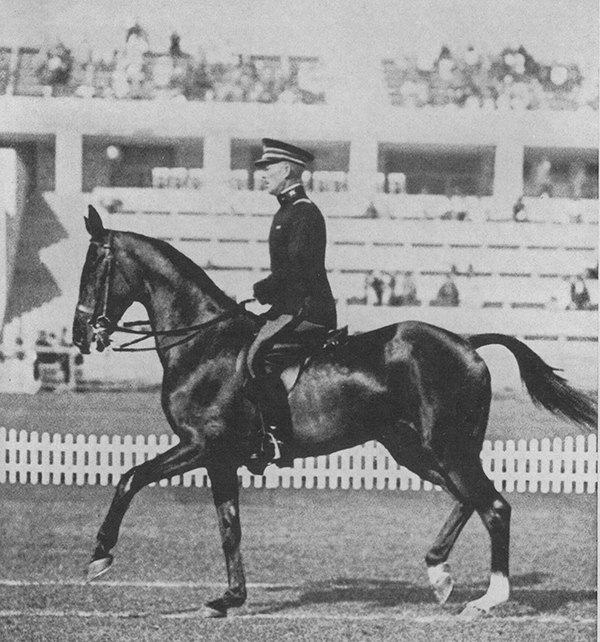
But Rau wasn’t only enthusiastic about his German riders, this is what he had to say about Captain Isaac Kitts and American Lady: “Passage. Nice, nearly majestical movements of the horse. Best harmony between rider and horse. The horse’s hind legs could follow a little more.”
In the same year he wrote another book with the title “Beurteilung des Warmblutpferdes”, which is also until our days, one of the best books about the evaluation of the exterior of riding horses.
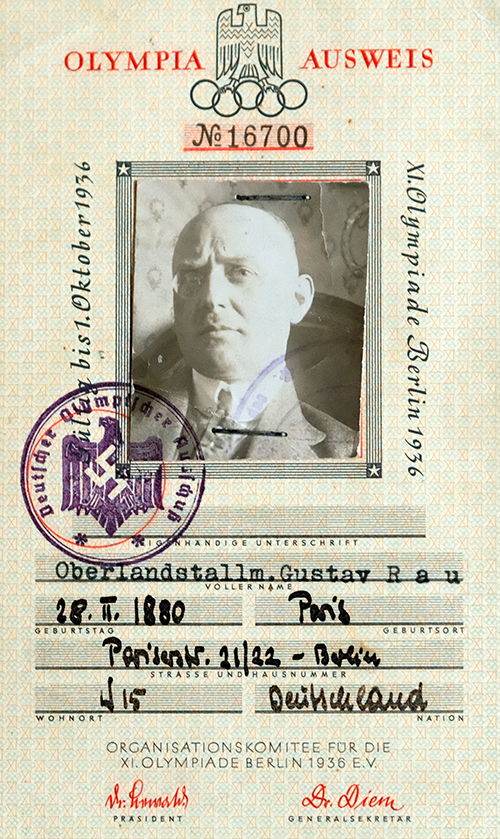
After the German Army invaded Poland in 1939, Rau was appointed by the German army to reorganize the Polish horse breeding in the occupied parts of Poland. In this context it is necessary to spotlight his rôle in the Third Reich from 1933 to 1945. It is proven that Rau was a completely apolitical character and that he was not a Nazi or member of the Nazi party NSDAP. But it has to be admitted that he was clearly an opportunist when it came to the Nazi regime. If it had advantages for the realization of his ideas about the development of horse sport and horse breeding, he flattered the Nazi regime and Adolf Hitler.
Rau was a supporter of the idea of the leadership principle, because in his own business of organization of horse sport and breeding he was also a kind of dictator. So in the equestrian world of Germany he was a somewhat controversial figure.
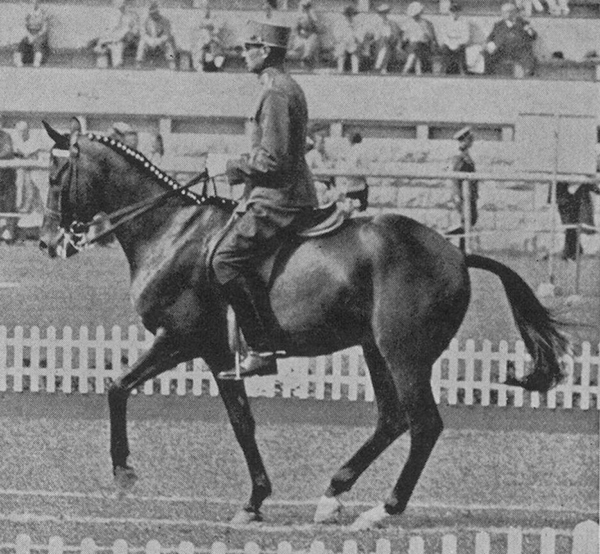
Rau was not impressed by the Austrian rider, Major Alois Podhajsky riding Nero: “Piaffe. Horse too short and too hasty in its steps. Not supple enough in the loins.” As Colonel Podhajsky, he went on to be the Director of the Spanish Riding School from 1939-65.
It is very interesting to see that after the end of the Second World War, Rau got very positive reviews from the Polish side for his work from 1939 to 1945 in Poland. He was a strong boss who demanded every time 100% commitment from his employees, but on the other side he was also ready to give more than 100% himself. Personally, he was completely uncaring about his own comfort. For example: If Rau had to make business trips, he tried to do it in the night because he wanted to have the day-time for working. 1943 he was awarded an honorary doctorate by the University of Bonn.
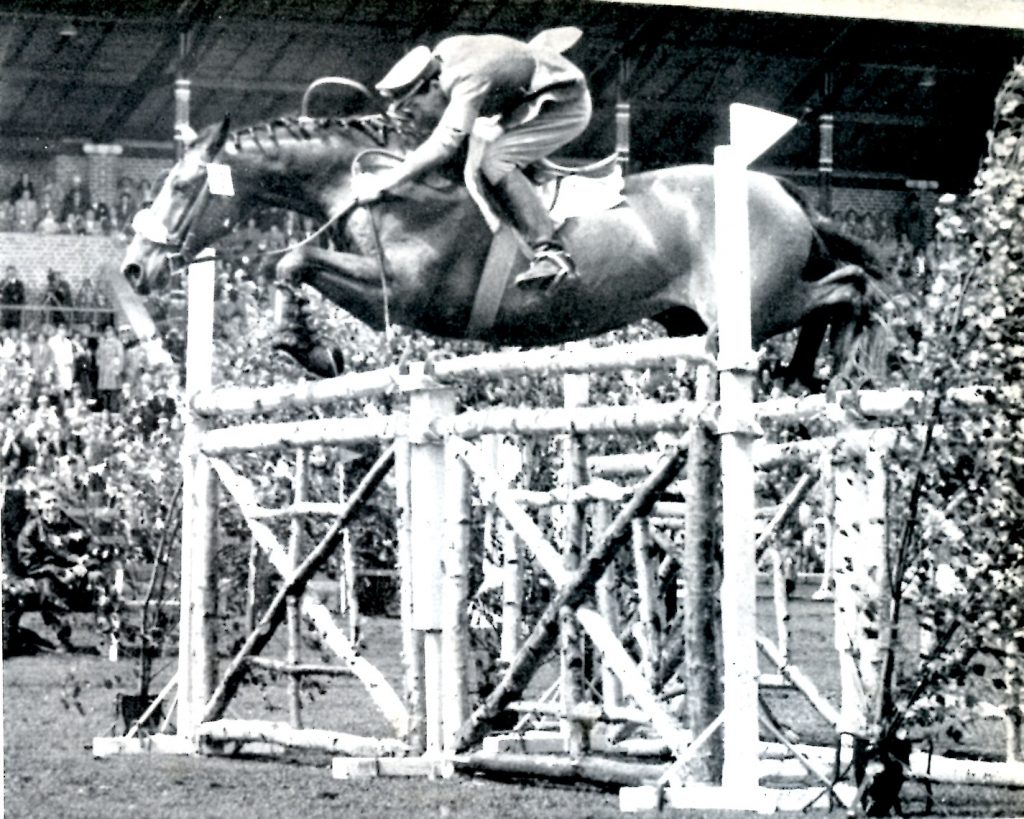
Hans Günter Winkler
After the Second World War, he reorganized the DOKR in a time when Germany was still mostly in ruins. After some trials to settle the headquarters of the DOKR in other towns, he came in 1950 to the small town Warendorf in Westphalia, where he found in a former cavalry school for the education of young horses, good training conditions for the DOKR. In a very short time, he assembled in Warendorf a group of riders – like the young show jumper Hans Günter Winkler, the farmer sons Alfons and August Lütke Westhues and the pupil Reiner Klimke who developed in the next years to be very successful riders in all three Olympic equestrian disciplines.
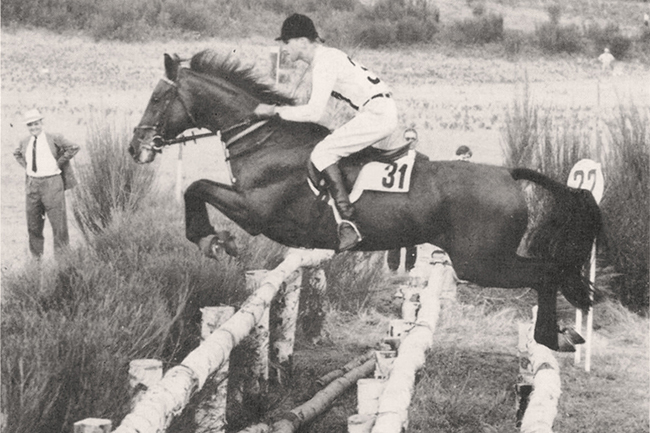
Reiner Klimke
In 1952, the Germans were for the first time after the Second World War allowed to take place at the Olympic Games in Helsinki. Despite of a lot of problems and bad luck, the German riders won one silver, and three bronze medals in eventing, dressage and show jumping…
In 1954 Rau organized a very successful trip for Hans Günter Winkler, who had won his first World Show Jumping Championship title. With some other German show combinations, they travelled to the USA and Canada. It was the first time that German horses were transported by an airplane to another continent. Only some days after his return to Warendorf he died suddenly in the age of 74 years sitting at his writing desk in the office of the DOKR.
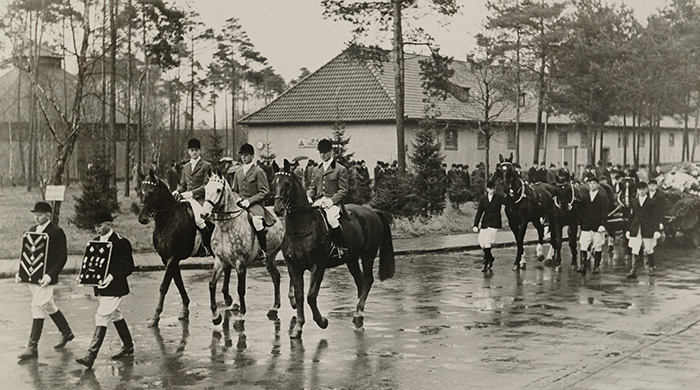
The funeral procession through Warendorf for Gustav Rau
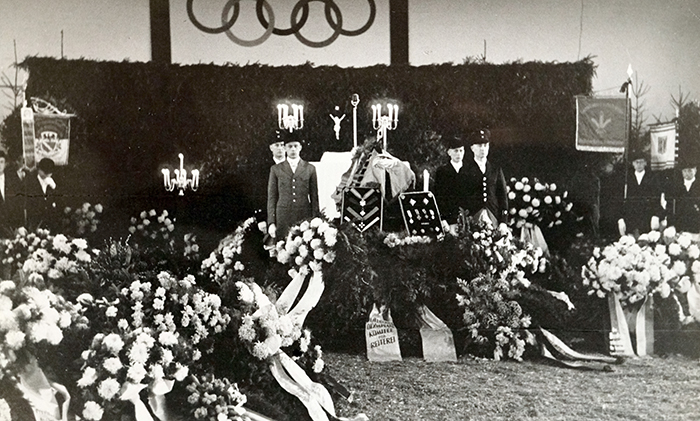
The funeral of Gustav Rau
For nearly half of a century Rau organized horse sport and horse breeding in Germany. He developed most of the structures, which are one secret of success of the Germans in the equestrian world. Also the town of Warendorf has a lot to thank him for, because he laid down the basis for their later worldwide image as the town of horses and riders.

This memorial stone was erected by the town of Warendorf in 1957, and later laid in the grounds of the DOKR and the German National Equestrian Federation (NF)
in the North of Warendorf.
Thank you Thomas
In his book, Die Reitkunst der Welt an den Olympischen Spielen 1936, Rau included a chapter – Suggestions for a Modern Riding Instruction based on the Classic German Tradition. It is hard to believe that his advice was written 80 years ago, Rau could be writing about the current dressage scene…
Could he have been warning against the Rolkur fad when he argued strongly that the equestrian future should be grounded in the past, on ‘the constructive work of many equestrian generations’ and warns against ‘speculative destructiveness’.
“Shaking with speculative destructiveness on the building of German equestrianism must be prevented.”
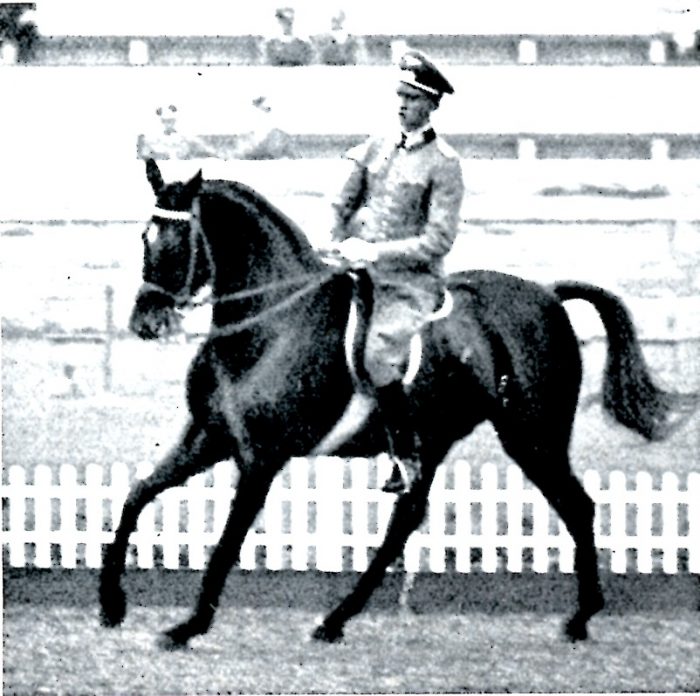
Kronos again, and even through the murk of the old black and white shot, you can see the relaxion in the horse’s body… Rau comments in his book, ‘Serpentine. Loop at the outer gallop to the right. Best kind of performance, determined, swinging with long regular strides…”
Rau assured his readers that any deviation from the time-honoured German way would only be temporary – a bit like the way Rolkur was finally discredited and banished – it still posed a threat:
“The temporary departure always takes place after exaggerations of what has been handed down, as they consist in holding the horses by too much influence with the hand, suppression of the natural paces, exaggeration of the artificial equilibrium. The reaction against the traditional is in the form of exaggerations in the opposite direction.”
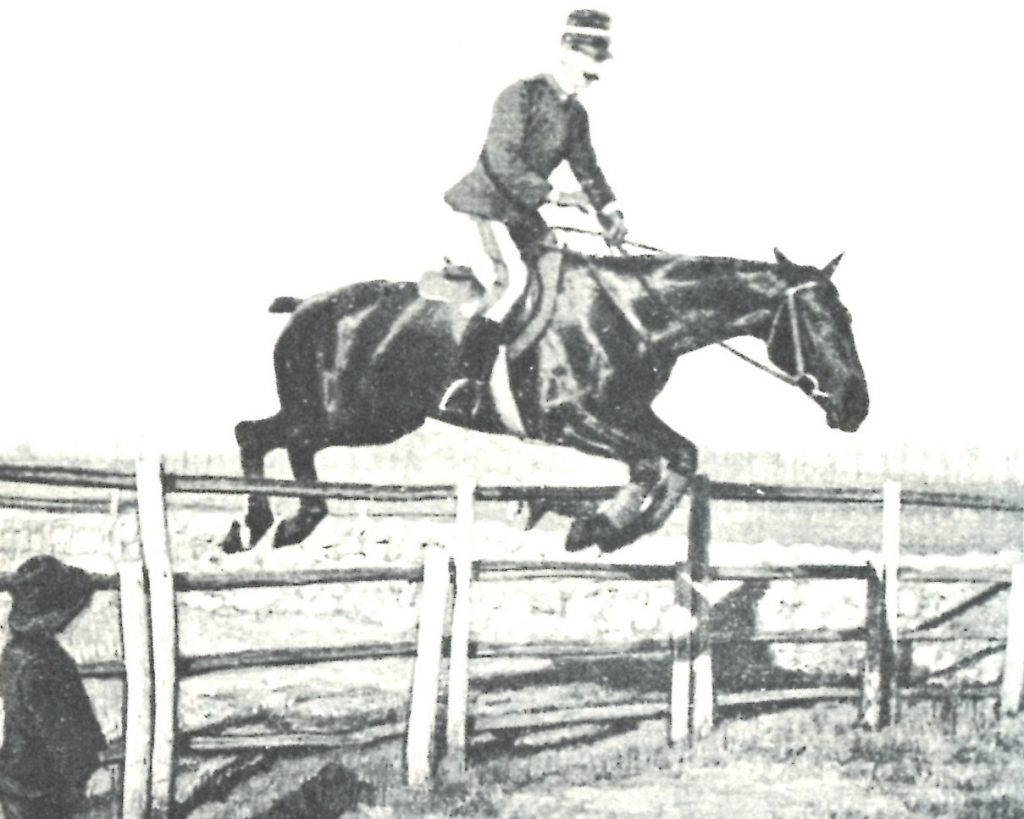
Caprilli – brilliant riding, flawed system…
He took aim at Caprilli and his “ingenious inspirations.”
“Caprilli wanted to keep the horse in his natural balance by fine tuning the rider, who carefully balanced himself with the horse. The smoothness should be achieved by a lot of galloping and jumping. The Caprilli system has no theoretical-scientific basics. It is a system of personal skill and therefore in its best form is not suitable for mass application. The personal skill that requires the truly successful handling of the Caprilli method is given to only a select few riders. It requires a great deal of sensitivity, a superior ability to balance, even virtuosity, even to correctly determine and carry out all degrees of mechanization… A system of horsemanship can only last in the long run if it meets all the requirements for the use of the horse for different purposes. The Caprilli method cannot be compared to a comprehensive equestrian system, because of its one-sidedness.”
It took Bertelan de Nemethy and his star pupil, George Morris, to fuse together the German principles with the forward seat of Caprilli, to produce – with a little French influence along the way – the doctrine of jumping riding that dominates the world today.
Reading Rau, one of the problems here is that we are so used to using the German principles, even if, in some cases unconsciously, that it is hard to imagine anyone seriously putting up an alternative. But there were other dangers to the German system, Rau also lined up the British born, French educated, James Fillis:
“The method of Fillis was completely adjusted to the kind of equestrian personality of its creator Fillis. Nor is it an actual system, but the fixed expression of the personal skill of a single towering rider. Fillis’ system was one-sided, because only the production of the school horse considered. With high collection you can not ride in the field. Fillis left behind some weak students. His system went out with the extinction of its founder. It was destined to die from the moment that Fillis could no longer show and execute it.”
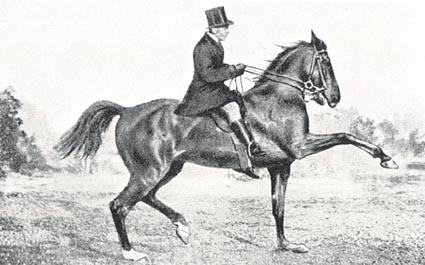
Fillis – another threat to civilised riding…
To get some idea of how different Fillis’ system was, you need to dip into his Breaking and Riding. The description of the complex flexing system before you even got on the horse goes for pages, and for the first ride, the horse is fitted out with a double bridle, and taught in a school walk, and a slow collected trot and a very styalised canter – remembering, of course, that Fillis was famous for teaching horses to canter to the rear.
Unliike Fillis with his highly collected frame, Rau argued for a longer, more natural way of going in the early stages of the horse’s education:
“From the gradual development of the dressage, to the increasing gymnastics of the horse, according to the different requirements to which the horse is to be used, it is a logical structure, a system that will survive as long as the conditions of the German people are ridden. A system that can always meet all requirements and contains the germ for the preparation of the horse to any kind of use – for the training of the horse for special purposes, such as cross-country riding, show jumping, and dressage tests at all the levels. No special systems are necessary whose one-sided fulfillment special detours of training but the total system provides in its various stages the degree of ‘throughness’ and its consolidation for horses for every purpose. The system of traditional German equitation creates in its gradual gymnastic training of the horse, the foundations for the future specialised skills.”
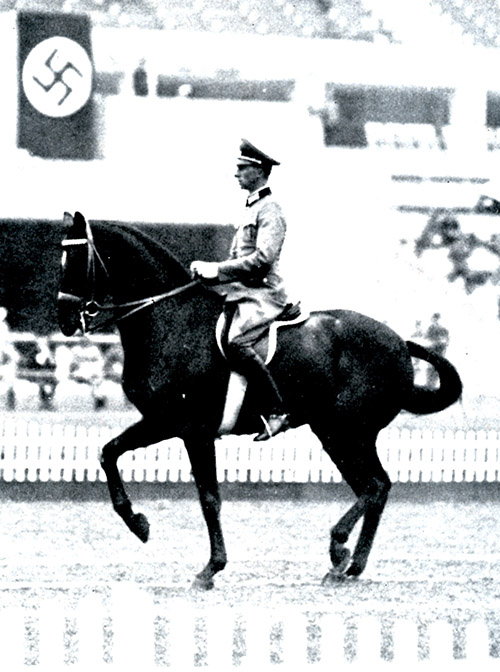
Kronos and Pollay again, the product of gradual gymnastic training. Rau comments:
The performance can be called a perfect Piaffe. Kronos shows plenty of suppleness. He trots on the spot. A wonder of equilibrium. He is doing his task on invisible aids of his excellently sitting rider.”
And Rau stressed the fluidity of the frame:
“The frame of the trained horse can be further stretched, the horse’s neck can be worn longer and freer, the guidance by the rider loose, lighter. The highly trained school horse must, as soon as the rider gives him the impulse, again return to its natural attitude. and not be constantly shortened. Just as it may not always be bent, but must always be quite straight. Even the highest dressage level, as well as the first, must never result in a permanent shortening of the horse in the forehand, especially in the neck. It relies on greater suppleness and the possibility of the lowering of the hindquarters, as the joints reach greater flexion. The horse must never be forced into a form by the harsh action of the rider. The outer form may arise only from the absense of all resistance in the horse and the full suppleness thus obtained. As long as there are tensions in the horse, resistances not overcome by suppleness, it is not permissible to proceed to collection and the pursuit of a posture that the horse can not easily adopt on its own.”
“The mistake some riders make, even in the beginnings of dressage, is to work the horse in a certain external form and posture that does violence to the horse, and must create stiff, held horses. The reaction to this wrong way should come with complete suppleness, so that the horse assumes of itself the outward form and posture that best suits his physique and thus is the right one. Dressage systems that see the achievement of the goal in a desired external form, such as high carriage or over-deep are false, tempting the rider to work from the outset by compulsion, to work on an external form that is not natural. If the art of riding, at all levels of education, remains in its task of striving and completing the suppleness of the horse, it fulfills its task and will cause no reaction or desire for other systems.”
“Anyone who tries to force his horse into an artificial posture from the beginning of dressage always acts contrary to the wisdom of a sensible horsemanship. Who, in order to get the school walk, wants to force the raw horse from the beginning of the dressage into the attitude of the school walk, can only get a short, broken walk. The correct school walk can only be the result of the perfect walk in the fluid and supple horse.”
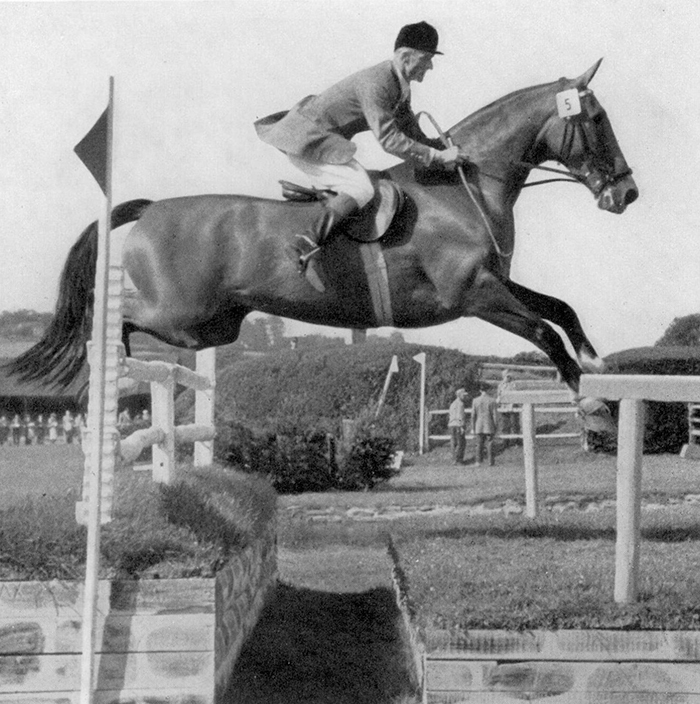
In an article written in the last year of his life, for L’Année Hippique 1953/1954, Rau paid tribute to three riders – one of them was Fritz Thiedemann seen here winning the 1953 Grand Prix of Aachen on Aar. The other two were Helga Köhler and Hans Gunther Winkler.
“The same is true of trotting and galloping: first of all suppleness through sensible gymnastics, then first the collecting, and thereby the desired posture and form of the horse. Every average horse must be brought to a high degree of suppleness, and therefore to be used with advantage in the lower stages of cavalry. However, not many horses can get to the highest level that they can ride with them, because they, like most people, do not have the physical predisposition and physical qualities required for great physical performance. The riders must recognize such horses and their inability for the highest dressage and not put them before tasks that they can not meet. Otherwise this leads to the resistance of the horse and useless tortures by the rider. Even if such horses fulfill the necessary external form by the technique and the will of the rider, the real harmony and the highest expression are missing in their performances.”
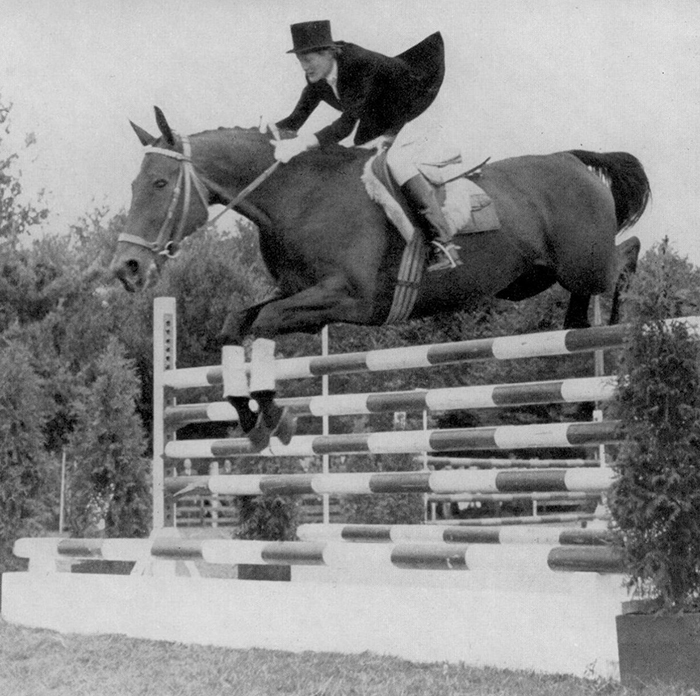
Helga Köhler and Armalva competing at Rotterdam in 1953 – sweet, natural riding…
In the section headed, Principles of Education, Rau pointed to the horse in its natural state:
“The young horse moves easily without a rider in the pasture, and in an absolute suppleness in its natural balance. It has no difficulty to change the pace of his movements in a rapid manner. It can do this faster than at any stage of the trained dressage horse under the rider. In the game with its companions in the pasture, the horse shows all the qualities naturally, and even more beautifully than it will later when it is trained. It turns, turns around, as we later call it, pirouettes. In the state of excitement it it explodes on the spot, as in the piaffe, or floats in high lifting elevated steps as it will later in the passage under the rider.”
“His halts, his jumps on his hind legs, reveal his perfect suppleness through the hindquarters. The horse bends his neck to the right and to the left, which is often stubbornly denied to the rider. It is capable of bending the neck and the spinal column laterally, while this bend later causes more or less difficulty under the rider. When we observe the horse in the pasture, we discover that it can do everything that it often denies for a long time under the rider and what can be reproduced only after a battle. In many cases, under the rider, suppleness will be gone forever. The horse does not give in, becomes stiff, despite all the effort to achieve full compliance of his individual body parts.”
story continues below the advertisement
Breeding a dressage star in Australia this season? Find all the European stars like
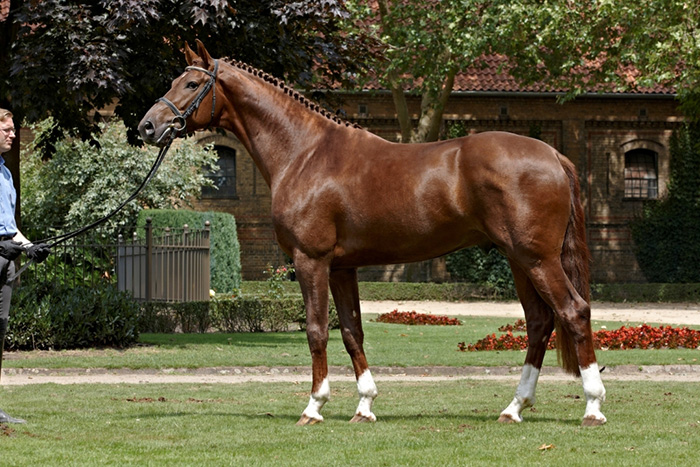
Vitalis
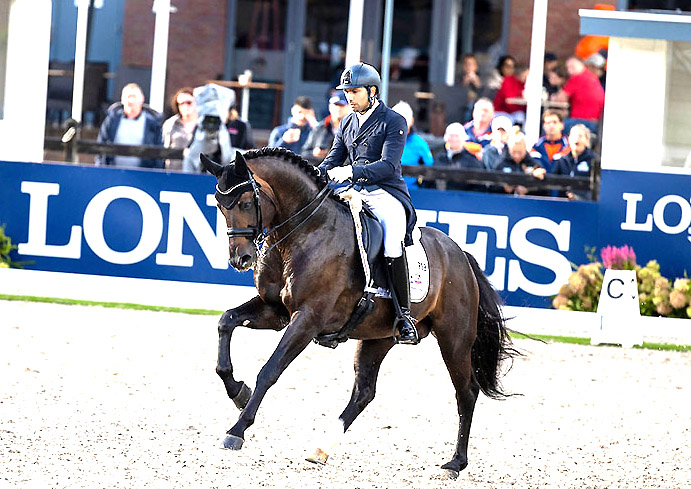
Escamillo
Go to www.ihb.com.au
“The rider has to adjust to seek by courtesy the horse’s suppleness. Only a rider with a supple seat and subtle influence can regain the natural smoothness of the horse and then, through fine riding and fine help, make the horse’s regained suppleness under the rider’s weight an ever-increasing one. The entire riding program must be designed so that it does not crumble in an endless struggle for the subjugation of the individual body parts of the horse, but it should try from the outset to make the whole horse in all body parts, in all joints and muscle groups yielding. The constant absolute adaptation of the rider to the natural balance of the horse demanded by the so-called natural horsemanship is no way for the mastery of the horse. This adaptation to the natural balance of the horse is useful only in the fast forward movement for example in the race and in fast riding over jumps, but does not create the balance between rider and horse in all movements and all situations, missing the basic requirement of the whole riding training process . Therefore, during the first training a new balance between rider and horse has to be established. Constantly adapting the rider to the horse’s balance gives the horse the initiative, so it does not create obedience. In contrast, finding the center of gravity between rider and horse keeps this at the disposal of the rider and ensures the rider’s influence on the horse.”
“Riding is a constant shifting of the centre of gravity between rider and horse, which depends on what the rider has to demand of the horse in the individual moments. Whenever the rider is forced to take decisive influence on the horse, propel it in the field or on the dressage arena, to jump obstacles, make a change of direction, he must adapt to the natural balance of the horse, and facilitate rapid forward movement. Sit up and go deeper into the saddle to secure the horse, that is, to be able to appeal to its suppleness. The rider’s upper body then approaches or reaches more or less the vertical. He brings the horse to the aids and can ensure its obedience.”
Forward, fluid, balanced, and above all, taking into account the level of the horse’s physical development, it is a system that is as relevant today as it was when Rau first formulated it, it’s a lesson that needs to be learnt over and over again…



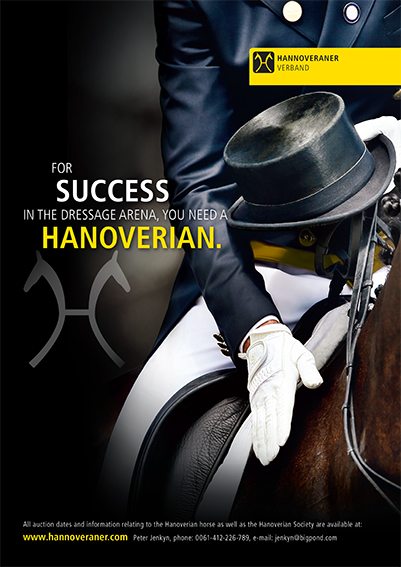
Excellent article 🙏
Great historical evaluation , must be a compulsory read for any aspiring horseman and JUDGES – the real back to basics .
Fabulous article.